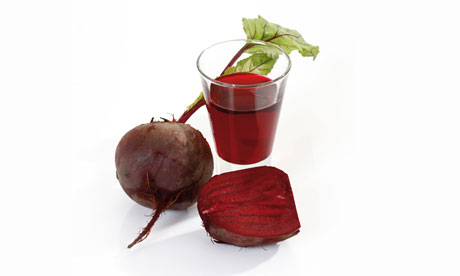
Boris Johnson has, this weekend, discovered the food secret to sporting prowess. Chatting backstage with four-time medal-winner David Weir, the Weirwolf apparently told Bozza – sotto voce – that he gets his energy each race from a special kind of shot.
Golly, thought Boris. "I had visions," the mayor reveals, "of some galvanic serum for reviving half-dead horses or patients in the throes of cardiac arrest: adrenaline, ketamine, a pint of brandy, perhaps." As it happens, Weir's booster was rather more homely: a shot of beetroot juice.
According to recent scientific research (no doubt radically simplified and defiled by the fourth estate), the nitrates found in beetroot can lower blood-pressure and increase stamina. "Surveys, schmurveys!" I hear the sceptics cry – and a healthy dose of cynicism is warranted in these matters, as every other week seems to bring new health claims - or scare story - for some foodstuff or other. But beetroot isn't some new fangled superfood, it's been appreciated by chefs, food lovers, and the health conscious for some time.
In the sporting arena, the Weirwolf is far from alone in his reverence for the ruby red root. Rugby chap Ben Foden also dabbles in beetroot, as do butterfly swimmer Ian Hulme and marathon runner Helen Decker. When they won the county championship in 2004, Warwickshire's cricketers were said to be following what's known as the Beetroot Diet.
For those of us used to eating it preserved and pickled from a jar, the vegetable has unhappy vinegar associations. Others have never got over its tendency to stain everything else on the plate. Some claim it tastes like dirt.
It was ever thus. Writing in the second century, Galen of Pergamon – the great Roman foodie – was not a fan, noting that Julian the Apostate, a Roman Emperor, was warned off the root by his doctor. A millennium and a half later, the poor beetroot gets a better press. As Alan Davidson records in the Oxford Companion to Food, herbalist John Gerard called it "a most excellent and delicate sallad" in 1633. Fifty years on, it had made its way into the cookbooks with salad recipist John Evelyn calling it "a grateful Sallet" that "the French and Italians contriv'd into curious figures to adorn [their veg]."
Today, it's often used in salads, but, says Graham Forber, managing director at G's Beetroot, it's high time we recognised the root's versatility. "It's very undervalued, underestimated, and underappreciated," he laments. "I like it roasted. You can put it on your barbecue." He recommends juicing it, as Weir does, making soup or eating it hot on its own. "You see lots of recipes now that use it with pastas."
And it does seem to be having a bit of a moment. Nigel Slater, who positioned himself as a beetroot guru back in January, points out that "ten years ago, beetroot was almost a goner." As he says, its "firmly in the spotlight now. It is almost impossible to find a menu that doesn't acknowledge its newfound popularity. At Bibendum it comes with cured herrings and warm potato salad, St John serves it with boiled egg and anchovies, and at River Cottage delis you find it in a sandwich with goat's cheese and thyme."
Yotam Ottolenghi recommends mixing it with yoghurt and preserved lemon relish, Hugh Fearnley-Whittingstall pairs it with mozzarella and balsamic. Slater suggests serving beetroot with lamb, or making it into fritters and pairing it with gravlax. The brave, he adds, might serve it with – or even in – a lentil curry; just don't be alarmed by the after-effects.

